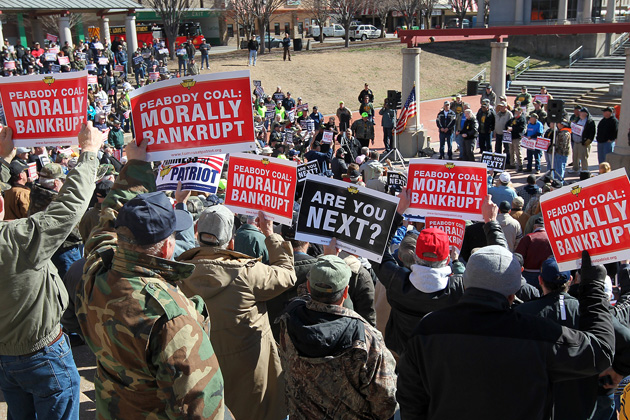By Clifford Krause, The New York Times, april 13, 2016
 |
| A protest rally against Peabody Energy. Coal mining is declining fast. |
Peabody Energy, the world’s largest publicly owned coal producer, with mines around the world from Australia to the United States, filed for bankruptcy protection in the United States on Wednesday.
The company was weighed down by the collapse of coal prices, increasing competition from natural gas and tightening regulations to control climate change.
The immediate crisis for the company, which is based in St. Louis, was its inability to sustain debt payments that financed its expansion in Australia in recent years to meet expected rising demand in Asia, particularly China. China is now trying to partly wean itself off coal to improve air quality.
The bankruptcy filing came as no surprise after the company announced last month that it was delaying interest payments on two loans. It comes after a number of bankruptcy filings over the last two years by other coal companies, including industry giants like Arch Coal, Patriot Coal, Walter Energy and Alpha Natural Resources.
“This was a difficult decision, but it is the right path forward for Peabody,” Glenn Kellow, the company’s president and chief executive, said in a statement. “This process enables us to strengthen liquidity and reduce debt, build upon the significant operational achievements we’ve made in recent years, and lay the foundation for long-term stability and success in the future.”
The collapse in natural gas prices over the last three years and new environmental regulations by the Obama administration have led to a rapid decline of the industry, especially in the Appalachia region, where mines are deep and expensive to operate. Domestic production last year slumped to a three-decade low.
Coal was once the provider of roughly half of the nation’s power, but it was surpassed by natural gas as the No. 1 source of electricity for the first time a year ago.
The Paris climate agreement signed in December has convinced many investors that the coal industry is in a death spiral. At the same time, there is a glut of coal on global markets, in part because of uneven economic growth in Europe and emerging markets.
But many analysts say the bankruptcy filings do not mean the coal industry will disappear. Under Chapter 11 bankruptcy protection laws, the companies have been exchanging debt to lenders for equity in the company, known in financial parlance as a debt-for-equity swap.
Most energy experts say coal will probably provide as much as a third of the nation’s power for years to come. They point out that several European and Asian countries continue to rely on coal for electricity, even as they try to turn more to renewable power sources like wind and solar.
Peabody still produces coal for customers in 25 countries on six continents.
“It’s a very mixed picture,” said Daniel Yergin, the energy historian and vice chairman of IHS, the energy consulting firm. “Coal plants in the U.S. will continue to retire, but coal will continue to be part of electricity generation in the United States.”
He added, “China’s plans, even with its renewables push, still show a rise in coal consumption.”
Peabody’s debt troubles, which have been standard across an industry that bet heavily on China and other international markets, originated in a 2011 offer of more than $4 billion for Macarthur Coal, an Australian supplier of metallurgical coal for Asian steel mills.
But expectations for growing Asian economies proved to be unrealistic. Growth in steel production in China was disappointing as the country began to shift its economy from exports toward more domestic consumption. At the same time, India is expanding its railroad system to connect its own coal fields to domestic industry.
Now, with the industry in near free fall, many banks are pulling away from financing coal projects. Utilities are closing aging coal-fired power plants rather than upgrade them to meet new environmental standards, in large part because the glut of natural gas has offered a cheaper alternative.
While filing for protection for its American assets in Federal Bankruptcy Court in the Eastern District of Missouri, Peabody disclosed that it has had problems selling holdings in Colorado and New Mexico. Peabody’s last best hope to avert bankruptcy was its attempt to sell three mines to Bowie Resource Partners, but that company has had trouble raising the full $650 million in debt to acquire them.
Not surprisingly, environmentalists who have been leading an effort to persuade investors and banks to divest from coal cheered the new bankruptcy.
“Peabody Energy’s bankruptcy is a harbinger of the end of the fossil fuel era,” said Jenny Marienau, United States divestment campaign manager with 350.org. “Peabody is crashing because the company was unwilling to change with the times — they doubled down on the dirtiest of all fossil fuels, and investors backed their bet, as the world shifted toward renewable energy.”
Peabody is cutting its payroll and otherwise curbing costs. Late last month, it cut 235 hourly and salaried employees from its North Antelope Rochelle mine in the Powder River Basin, roughly 15 percent of the mine’s work force.
Shares of the company have sold for around $2 in recent days after plunging in value by 99 percent since its high in 2008 just before the financial crisis.
No comments:
Post a Comment